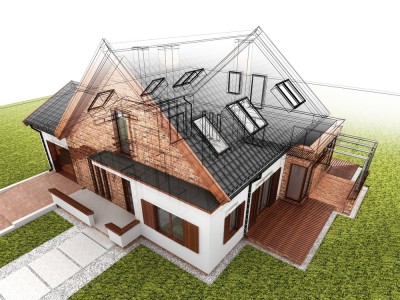By Vince Mancuso, Storage.com
Whenever you’re changing homes, you have a lot to think about. Let Storage.com help you navigate the process with tips on buying, selling, or renting, or with some additional space to help along the way.
Are you considering to start or currently beginning construction for a new home? Then you’re not alone. According to the U.S. Department of Housing and Urban Development, roughly 620,000 new single-family homes were constructed in 2014, and experts are already expecting 1.1 million housing starts in 2015—715,000 of those being single-family homes.
Building a home can be awesome experience as you see your very own dream home take shape before your very eyes—or so the fantasies and reality TV shows make it appear. In reality, it can be a tricky time in your life to match up with the right builder, stay within budget, and ensure that you have a new home that will last. Following the right steps, building a new home can be that fun, delivering process that you had hoped it would be.
To help you on your way to building a new home, here are some things you need to know.
1. You Need to Count the Cost
The very things you should do when considering building a new home is the cost and whether or not it’s one you can afford. Are you looking for features you can’t afford? Do you want a two-story or a ranch? Is it worth it to build further outside of town or do you want to live in a popular neighborhood?
To help you determine if you can afford the home you want, the majority of home plans provide a cost tool to help get an accurate estimation of the construction costs. This tool should include the cost of construction, funds for the down payment, tax benefits, and other factors.
2. Architect vs Pre-Drawn Designs

When it comes to the actual design of the home, you have two options: hire someone to draw up a plan or use something pre-drawn. As you’re building the home you dreamed of, it should go without saying that having the right design is personal to you and your situation, which is why an architect or house designer may often sound like the best option, but that isn’t always the case.
Use an architect if you want a truly unique home or need help to overcome particular obstacles you may have, such as space restrictions. On the other hand, if you are eager to get into a new home or cannot afford an architect, there are a significant number of pre-drawn house plans that are both cheaper than an architect and can be more quickly constructed. You can even modify a pre-drawn plan to include those must-have features, like that wrap-around porch you’ve always wanted.
3. Think Long-Term
As you’re undergoing the construction process, it’s important to look at your house while considering where it—and you—may be 10 to 20 years from now. For starters, look at the energy efficiency. Is your insulation going to keep heat in the winter and block a summer swelter? Are the windows placed to maximize natural lighting? Small things like this can have a lasting impact on a house for decades.
And as for decades, it’s safe to assume that this house will be sold some day, so what choices are you making now with resale in mind? For instance, avoid overpricing your home for your neighborhood by having too many upgrades. Additionally, while it’s nice to have a more personal-touch to your home, make sure any features you purchase have a general appeal to attract future home-buyers.

4. Find the Right Builder
To make sure you get a quality home in an acceptable timeline, it’s important to find the right builder. Do your homework to find online reviews of the builders your considering and look for credible backing such as whether or not the builder is a member of the National Association of Home Builders.
It is also important to meet with the builder personally and ask questions. NewHomeSource.com offers 15 questions for home builders that can help give you confidence in your choice. These questions can be basic, such as how many years have you been in business and how many homes have you built? Or more in-depth questions, such as what major energy-saving features do you install or do you have any reference from past home buyers?
5. Begin Shopping Now
According to the the Wall Street Journal, the average home construction time is about 5 to 8 months to complete depending on what part of the country you live in. And while you may have found a reliable builder, sometimes the uncontrollable happens and delays will occur. However, you don’t have to wait for a move-in date to purchase new furniture and appliances for your home.
If you want to take advantage of temporary deals for appliances or pick up a piece of furniture you won’t be able to later, you can do so while you’re home is being constructed with the use of a storage unit. Self storage allows you to store items in a safe location by finding a storage facility with security features such as on-site management and video surveillance as well as protect items from the weather with climate-control, a feature that maintains a moderate temperature and humidity level inside the unit.





